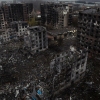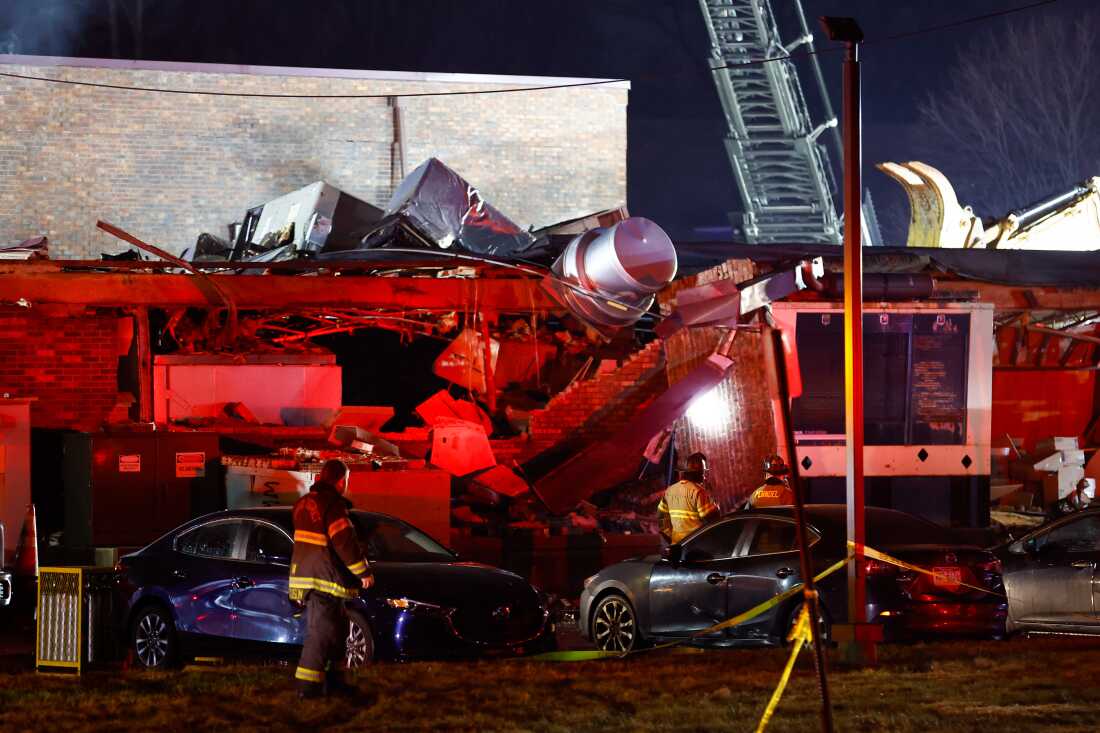Moscow declared a state of emergency in two regions after a major Ukrainian drone strike caused large explosions at a military airfield and Kyiv pursued its most ambitious incursion into Russian territory in a decade of war.
The unexpected offensive, which raged into a fourth day on Friday, is the largest attack by Kyiv’s forces on Russian soil, not only since President Vladimir Putin launched his full-scale invasion of Ukraine in 2022, but at least since the Kremlin’s covert invasion of Crimea and the Donbas 10 years ago.
The assault aims to divert Russia’s troops from the east, expose its weaknesses and strengthen Kyiv’s position in future negotiations with Moscow, said an adviser to the government, after months of Russian gains on the more than 1,000km-long front of the grinding war within Ukraine.
A state of emergency was declared in the Russian regions of Kursk and Lipetsk, where Ukrainian forces were engaged in fierce fighting on Friday.
Friday’s drone assault added a complicated new dimension to the incursion, which dwarfs several previous cross-border raids conducted by anti-Moscow Russian volunteer fighters and a far-right militia operating under the command of Ukraine’s military intelligence directorate.
Some military analysts have questioned the timing of the Kursk operation and the redeployment of some of its elite units at a time when Ukraine’s army is already struggling to defend the frontline in the Donetsk region.
Elements of at least four Ukrainian mechanised and airborne brigades have taken part in the operation so far. In videos verified by the Financial Times and military analysts, they have been seen using US Stryker and German Marder fighting vehicles provided to Kyiv as part of military assistance packages worth billions of dollars.
US and German officials said the armoured vehicles inside Russia had not violated the conditions of their use, despite previous objections by Washington and other western governments to such weaponry being used within Russia over concerns that Moscow might escalate the war.
Gas prices in Russia rose sharply. Kursk contains a crucial transit corridor for gas supply to Europe.
As Kyiv pressed on with its incursion, Russia responded with an attack on a busy supermarket and post office in the eastern Ukrainian city of Kostyantynivka on Friday, which killed at least 12 civilians and injured 44 more, said President Volodymyr Zelenskyy and local authorities.
Officials published videos showing black smoke billowing from a destroyed store and first responders working to save shoppers trapped under debris. Another video showed badly wounded people sprawled on the pavement.
The overnight drone attack on Russia was carried out by Ukraine’s security service, the SBU, with the military and special forces early on Friday, a Ukrainian official with knowledge of operations inside Russia told the Financial Times.
The official said the Lipetsk air base — about 300km from the international border and just east of the latest fighting — was targeted “to destroy Russian aviation logistics so that the enemy does not have the opportunity to bomb Ukrainian cities with anti-aircraft missiles”.
Several warehouses filled with ammunition were detonated, the official said. Videos published on social media and geolocated by the Financial Times showed huge explosions reaching into the night sky.
The Ukrainian official claimed that up to 700 glide bombs stored in the warehouses were damaged or destroyed. Several dozen fighter jets, including Su-34, Su-35 and MiG-31 aircraft, along with military helicopters, were also at the air base, said the general staff of Ukraine’s army.
“Most of the planes stationed at the military airfield . . . did not have time to take off,” the Ukrainian official claimed.
The FT could not immediately verify whether the bombs and aircraft had been damaged or destroyed. Russian military bloggers reported that no aircraft were damaged.
Large explosions 🔥 are currently taking place at Lipetsk Airbase in Russia located 282km from Ukraine 🇺🇦
The air bases has Su-34s, MiG-29s, Su-25s, and at times 2x Su-57s pic.twitter.com/67nwegTn7l
— Ukraine Battle Map (@ukraine_map) August 9, 2024
Videos shared on Russian Telegram channels showed lines of civilian vehicles stretching several kilometres fleeing east from the Lipetsk and Kursk regions.
The Ukrainian official said the Lipetsk attack was a follow-up to a Monday assault on the Morozovsk military base in Russia’s Rostov region that had destroyed anti-aircraft missiles and jet fighters.
Ukraine’s general staff said its forces had also attacked Russian anti-aircraft missile divisions in the occupied territory of eastern Donetsk.
Those attacks came as Ukrainian forces pressed forward with their assault in the neighbouring Kursk region, where the Kremlin has lost control of roughly 350 sq km of territory, according to calculations by the FT and military analysts.
Alexei Smirnov, the Kursk region’s acting governor, said the situation remained “difficult”. He said his government had declared a state of emergency, was still evacuating residents and was assisting those displaced.
Pentagon deputy press secretary Sabrina Singh told reporters in Washington on Thursday that Ukraine was “taking action to protect themselves” and that the Biden administration did not see the incursion as escalatory.
Video and photo evidence suggested that Ukraine’s army has moved as deep as 35km into Russia from the international border, down a highway heading north-west.
A video circulating on social media that the FT geolocated to a highway in Rylsk showed a destroyed column of Russian military vehicles transporting soldiers that stretched for hundreds of metres. The bodies of several troops are seen in the gruesome video.
A person with knowledge of the operation shared a video with the FT purporting to show a first-person-view (FPV) camera-equipped drone armed with an explosive as it crashed into the tail rotor of a Russian military helicopter.
The person said the SBU was behind the strike — the second Ukrainian FPV drone attack on a Russian helicopter this week. The person said both helicopters crashed as a result of the strikes, but the FT was unable to independently corroborate the claims.
On Friday afternoon, Russian state media aired footage of large convoys of military trucks transporting heavy weaponry towards the fight in Kursk.
Zelenskyy has not explicitly commented on the incursion, but thanked Ukrainian troops on Friday for “destroying the Russian occupiers, holding the frontline, and ensuring that Ukraine remains on the world map”.
“We are doing our best to provide our warriors with as many opportunities as possible to end this war as soon as possible with a just and lasting peace,” he said.
Andriy Zagorodnyuk, a former Ukrainian defence minister who advises the government, told the FT that Kyiv had planned the operation long in advance.
Zagorodnyuk said its aims included diverting Russian troops fighting elsewhere in Ukraine, as well as bringing the war home to Russians and discouraging them from supporting the war effort.
It also aimed to expose Russia’s weaknesses, including that it was incapable of protecting its own border, and to try to seize the initiative on the battlefield a year after an unsuccessful counteroffensive, and following months of Russian gains.
Zagorodnyuk said the Ukrainian military was proving its ability to conduct “new tactics of combined arms operation” taught by western military trainers.
He said the aim was not to capture and hold Russian territory “for long”. “We don’t need Russian land,” he said. “We want them to fail on ours.”
Konrad Muzyka, a military analyst at Rochan Consulting, a Poland-based security group, said the Ukrainian operation could help its position in the war if it forced Russia to divert resources from eastern Donetsk and allowed Kyiv to maintain a presence in Russia’s Kursk region.
That presence might offer a better negotiating position in future, he said.
“If Ukrainian troops, however, are pushed back from the Russian territory without any tangible results with high losses and if Russians continue moving towards Pokrovsk [in Donetsk],” he said, then Ukraine’s top military leadership would be seen as having lost a huge gamble.
“There is no middle ground here. The operation is daring,” he said.
Ukraine separately claimed on Friday to have landed on the Kinburn Spit, a long strip of land jutting into the Black Sea that has been occupied by Russia since March 2022.
Video footage posted by Ukraine’s military intelligence showed troops landing by jet ski. “The Kinburn spit will be free, like all other temporarily occupied territories of Ukraine,” read an official post on Telegram.
Additional reporting by Max Seddon in Riga, Anastasia Stognei in Tbilisi and Isobel Koshiw in Kyiv












































